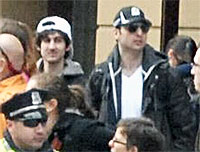The motivation of the Boston Bomber: The ethnic background of the Tsarnaev family must provide some clues to mass murder.

(opendemocacy.net – Susan Richards – April 23, 2013)
Susan Richards is a non-executive director and founder of openDemocracy. She has produced a number of feature films and written a prize-winning book, Epics of Everyday Life, about the lives of ordinary Russians in the transition from communism. Lost & Found in Russia, Encounters in the Deep Heartland, which covers the period 1992-2008, was published by IB Tauris in May 2009.
Dzhokar Tsarnaev, the man who has been charged with the Bostom bombings, fits the profile of a young man who was about to realise the American Dream. His parents had reached America, escaping a rootless past in Kazakhstan and Dagestan. He had brains, a university place and a bright future in his adopted home. So what went wrong? A week after the bombings the teenager’s motivation still seems obscure. Although the Tsarnaev family never seem to have lived in Chechnya, their ethnicity must at the very least provide some clues.
Chechnya lies in the formidable range of mountains stretching from the Crimea to the Caspian. Its mountain culture has been formed by its remoteness and it has realised itself spectacularly in its resistance to the threat of conquest. Its tight family and clan structures are bound together, as much as those of Sicily, by inward-facing codes of honour and loyalty.
From the late eighteenth century onwards, when Russia’s imperial troops first started to engage with the clans of the North Caucasus, the resistance of the warriors of the North Caucasian Chechens, Circassians, Dagestanis and others – became legendary. This was Russia’s Wild West, the territory which inspired Pushkin and Lermontov. Islam arrived late to the region, and only stiffened their resolve.
Through sustained campaigns of exemplary brutality Russia’s army did manage to subdue the Chechens. But the conquerors had good reason to suspect that the Chechens were never fully reconciled to Russian conquest. Which is why in February 1944, after the Wehrmacht invasion, Stalin deported every Chechen man, woman and child to Kazakhstan. Stalin did not trust them not to join forces with the invading army. Only after 1957 were they allowed to return home to the North Caucasus.
From Kazakhstan, the Tsarnaev family may have moved back to Dagestan as opposed to Chechnya. But they cannot have been unaffected by the fall-out of the two catastrophic wars that broke out when the dream of Chechen independence from Russia reared its head again, when communism ended. These wars, which finally ended in 2009, saw one of the world’s largest standing armies pulverise an ethnic group of little more than a million people.
In the course of those wars, Chechnya’s independence struggle morphed into the larger global cause of militant Islamism. The Salafite strain of Islam entered the region’s bloodstream. It spread to neighbouring Dagestan, which is now on the brink of civil war. Dagestan, which I visited recently, has now become the main focus of Russia’s battle with militant Islam. Last year 115 police were killed in the struggle being fought on the streets of Makhachkala. Bombings and shootouts are everyday occurrences.
The corruption which is widespread in Russia today as a whole is infinitely worse in Dagestan. As a student, you have little chance of getting through university unless you can pay the bribes. Unemployment is high. Everything, from jobs to university degrees, is for sale. The temptation for the young to join the underground resistance is not hard to understand.
At this juncture it is pointless to speculate about the particular cocktail of circumstances which turned the Tsarnaev brothers into mass murderers. But two points stand out. Firstly, this is not a straightforward story of immigrants living in cultural isolation. More, perhaps, to do with the challenge that America’s syncretic, melting-pot culture posed to young men brought up in a culture so inward-turned and fiercely defensive. The young men had certainly made efforts to integrate. Tamerlan, the older brother, had even married a non-Chechen, Katherine Russell, and started a family. This suggests that he had, at some stage, made the commitment to turn his back on his culture and embrace the multi-cultural American mainstream. ‘Marrying out’ is difficult for a Chechen. Had the family all remained in Dagestan, his parents would traditionally have sought out a Chechen girl for him to marry. Although his wife clearly adopted his faith when he turned back to Islam, she remained an American.
Tamerlan’s story looks to be one of a young man who felt that he had closed the door on one culture without being able to open it on the other. ‘I don’t have a single American friend. I don’t understand them,’ he has been quoted as saying, adding: ‘There are no values any more. People cannot control themselves.’
So what of the surviving younger brother Dzhokar? Once the parents moved back from America to Dagestan, tradition would have dictated that his older brother would assume responsibility for him in a binding way. Whatever his own views may turn out to be, his loyalties to his brother came first. They came higher than pursuing the American Dream.
Article also appeared at http://www.opendemocracy.net/susan-richards/motivation-of-boston-bombers bearing the following notice:
 This article is published under a Creative Commons licence. If you have any queries about republishing please contact us. Please check individual images for licensing details.
This article is published under a Creative Commons licence. If you have any queries about republishing please contact us. Please check individual images for licensing details.
